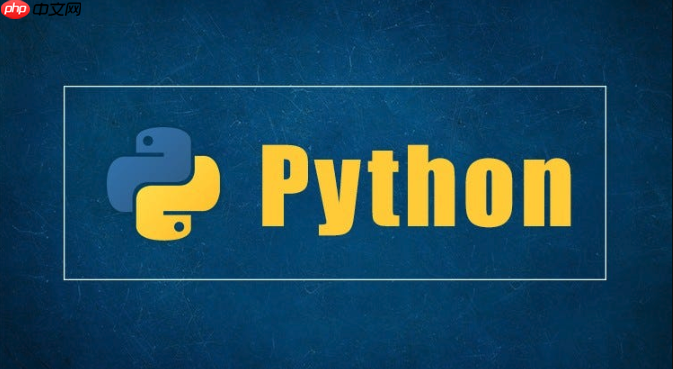多线程适合图像处理因其能有效利用I/O等待时间,提升批量读写效率。尽管Python的GIL限制了CPU密集型任务的并行执行,但在涉及大量文件操作的场景下,多线程仍可通过并发调度加快整体处理速度。文章以Pillow库为例,展示了使用threading模块手动创建线程进行图像缩放的方法,并指出其需手动管理线程数的缺点。为简化并发控制,推荐使用concurrent.futures的ThreadPoolExecutor,它能自动管理线程池,使代码更简洁安全。示例函数fast_batch_resize通过映射任务到线程池,实现高效批处理。同时提醒设置合理线程数(通常4-8)、避免内存溢出、捕获异常及确保路径有效性,尤其在处理上百张图片时,性能提升显著。

图像处理任务通常是I/O密集型或CPU密集型操作。比如从磁盘读取图片、应用滤镜、调整大小、保存结果等步骤中,等待文件读写的时间远大于实际计算时间。Python的多线程能在I/O等待期间切换任务,提升整体吞吐量。虽然由于GIL(全局解释器锁)的存在,多线程无法真正并行执行CPU密集型任务,但在涉及大量文件读写的批量处理场景下,依然能显著加快速度。
下面是一个使用标准库threading和os结合Pillow(PIL)进行多线程图像缩放的例子:
安装依赖:
立即学习“Python免费学习笔记(深入)”;
<font face="Consolas, 'Courier New', monospace">pip install pillow</font>
代码示例:
from PIL import Image import os import threadingdef resize_image(file_path, output_dir, size=(800, 600)):
try:
with Image.open(file_path) as img:
img = img.resize(size, Image.Resampling.LANCZOS)
filename = os.path.basename(file_path)
output_path = os.path.join(output_dir, filename)
img.save(output_path, "JPEG")
print(f"✅ 已处理: {filename}")
except Exception as e:
print(f"❌ 处理失败 {file_path}: {e}")
def batch_resize(image_dir, output_dir, size=(800, 600), max_threads=4):
if not os.path.exists(output_dir):
os.makedirs(output_dir)
image_files = [os.path.join(image_dir, f) for f in os.listdir(image_dir)
if f.lower().endswith(('jpg', 'jpeg', 'png'))]
threads = []
for file_path in image_files:
while threading.active_count() > max_threads:
pass # 等待线程数下降
thread = threading.Thread(target=resize_image, args=(file_path, output_dir, size))
threads.append(thread)
thread.start()
for t in threads:
t.join() # 等待所有线程完成
print("? 批量处理完成!") 使用方法:
batch_resize("input_images/", "output_images/", size=(1024, 768), max_threads=5)相比手动管理线程,concurrent.futures提供了更高层的接口,推荐用于实际项目。
from concurrent.futures import ThreadPoolExecutor
import os
from PIL import Image
def process_single_image(file_path, output_dir, size):
try:
with Image.open(file_path) as img:
img = img.resize(size, Image.Resampling.LANCZOS)
filename = os.path.basename(file_path)
output_path = os.path.join(output_dir, filename)
img.save(output_path, "JPEG")
return f"✅ 完成: {filename}"
except Exception as e:
return f"❌ 错误: {os.path.basename(file_path)} - {e}"
def fast_batch_resize(image_dir, output_dir, size=(800, 600), max_workers=4):
if not os.path.exists(output_dir):
os.makedirs(output_dir)
image_files = [os.path.join(image_dir, f) for f in os.listdir(image_dir)
if f.lower().endswith(('jpg', 'jpeg', 'png'))]
with ThreadPoolExecutor(max_workers=max_workers) as executor:
results = executor.map(
lambda x: process_single_image(x, output_dir, size),
image_files
)
for result in results:
print(result)
print("? 全部图片处理完毕。")这种方式自动管理线程池,无需手动控制并发数量,代码更清晰安全。
在使用多线程处理图像时注意以下几点:
multiprocessing绕过GIL限制基本上就这些。合理使用多线程能让图像批处理快上几倍,特别是面对上百张图片时效果明显。
以上就是Python多线程在图像处理中的应用 Python多线程批量处理图片教程的详细内容,更多请关注php中文网其它相关文章!

每个人都需要一台速度更快、更稳定的 PC。随着时间的推移,垃圾文件、旧注册表数据和不必要的后台进程会占用资源并降低性能。幸运的是,许多工具可以让 Windows 保持平稳运行。

Copyright 2014-2025 https://www.php.cn/ All Rights Reserved | php.cn | 湘ICP备2023035733号